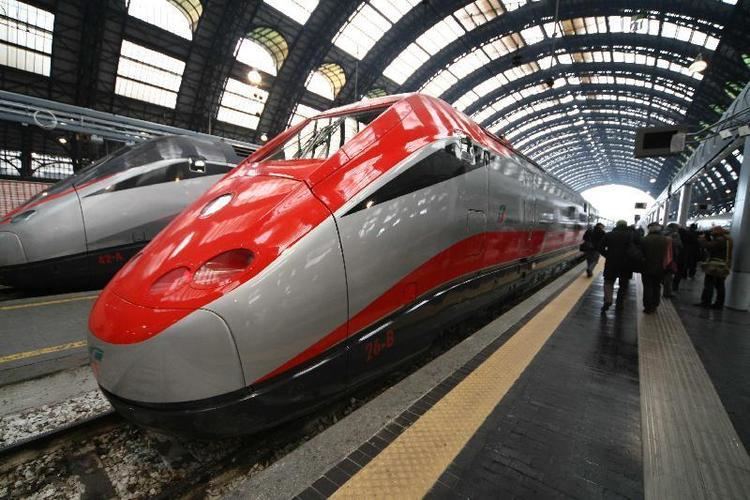National railway Ferrovie dello Stato Double track 7,505 km (4,663 mi) | Total 16,723 km (10,391 mi) | |
 | ||
Major operators Trenitalia (national)Nuovo Trasporto Viaggiatori (national)Trenord (local)Ferrovie Emilia Romagna (local)Thello (international) Main 1,435 mm (4 ft 8 ⁄2 in) standard gauge 3 kV DC 11,921 km (7,407 mi) (conventional lines) | ||
The Italian railway system is one of the most important parts of the infrastructure of Italy, with a total length of 24,227 km (15,054 mi) of which active lines are 16,723 km. The network has recently grown with the construction of the new high-speed rail network. Italy is a member of the International Union of Railways (UIC). The UIC Country Code for Italy is 83.
Contents
The network
RFI (Rete Ferroviaria Italiana, Italian Rail Network), a state owned company, administers most of the Italian rail infrastructure. The total length of RFI active lines is 16,723 km (10,391 mi), of which 7,505 km (4,663 mi) are double tracks. Lines are divided into 3 categories:
Most of the Italian network is electrified (11,921 km (7,407 mi)). Electric system is 3kV DC on conventional lines and 25 kV AC on high-speed lines.
The Italian rail network comprises also other minor regional lines controlled by other companies for a total of about 3,000 km.
History
The first railway in Italy was the Napoli-Portici line, built in 1839 to connect the royal palace of Naples to the seaside. After the creation of the Kingdom of Italy in 1861, a project was started to build a network from the Alps to Sicily, in order to connect the country.
The first high-speed train was the Italian ETR 200, which in July 1939 went from Milan to Florence at 165 km/h (103 mph), with a top speed of 203 km/h (126 mph). With this service, the railway was able to compete with the upcoming airplanes. The Second World War stopped these services.
After the Second World War, Italy started to repair the damaged railways, and built nearly 20,000 km (12,000 mi) of new tracks.
Nowadays the rail tracks and infrastructure are managed by Rete Ferroviaria Italiana (RFI), while the train and the passenger section is managed mostly by Trenitalia. Both are Ferrovie dello Stato (FS) subsidiaries, once the only train operator in Italy.
High-speed rail
High-speed trains were developed during the 1960s. E444 locomotives were the first standard locomotives capable of top speed of 200 km/h (120 mph), while an ALe 601 electrical multiple unit (EMU) reached a speed of 240 km/h (150 mph) during a test. Other EMUs, such as the ETR 220, ETR 250 and ETR 300, were also updated for speeds up to 200 km/h (120 mph). The braking systems of cars were updated to match the increased travelling speeds.
On 25 June 1970, work was started on the Rome–Florence Direttissima, the first high-speed line in Italy. It included the 5.375 km (3.340 mi) long bridge on the Paglia river, then the longest in Europe. Works were completed in the early 1990s.
In 1975, a program for a widespread updating of the rolling stock was launched. However, as it was decided to put more emphasis on local traffic, this caused a shifting of resources from the ongoing high-speed projects, with their subsequent slowing or, in some cases, total abandonment. Therefore, 160 E.656 electric and 35 D.345 locomotives for short-medium range traffic were acquired, together with 80 EMUs of the ALe 801/940 class, 120 ALn 668 diesel railcars. Some 1,000 much-needed passenger and 7,000 freight cars were also ordered.
In the 1990s, work started on the Treno Alta Velocità (TAV) project, which involved building a new high-speed network on the routes Milan – (Bologna–Florence–Rome–Naples) – Salerno, Turin – (Milan–Verona–Venice) – Trieste and Milan–Genoa. Most of the planned lines have already been opened, while international links with France, Switzerland, Austria and Slovenia are underway.
Most of the Rome–Naples line opened in December 2005, the Turin–Milan line partially opened in February 2006 and the Milan–Bologna line opened in December 2008. The remaining sections of the Rome–Naples and the Turin–Milan lines and the Bologna–Florence line were completed in December 2009. All these lines are designed for speeds up to 300 km/h (190 mph).
Other proposed high-speed lines are Salerno-Reggio Calabria, then connected to Sicily using the future Strait of Messina Bridge, and Naples-Bari.
Rail links to adjacent countries
All links have the same gauge.
Stations on the border are:
Subsidies
The Italian railways are partially funded by the government, receiving €8.1 billion of rail subsidies in 2009.
Categories and types of trains
These are the major service categories and models of Italian trains.
